International Journal of Scientific & Engineering Research, Volume 3, Issue 6, June-2012 1
ISSN 2229-5518
Heat and Mass Transfer in MHD Boundary Layer Flow past an Inclined Plate with Viscous Dissipation in Porous Medium
P. K. Singh
Department of Mathematics, University of Allahabad, Allahabad- 211002, India.
Abstract— In the present paper, the problem of a steady two dimensional hydromagnetic convective flow of a viscous, incompressible elec trically conducting fluid past an inclined plate in porous medium has been studied. The convective flow starts u nder the simultaneous action of the buoyancy forces caused by the variations in density due to temperature and species concentr ation differences. The effects of viscous dissipation have been taken into account and the partial differential equations governing the boundary layer flow are converted into a system of ordinary differential equations by using suitable similarity transformations. These equations are solved numerically and effects of various parameters on the flow fields are investigated and presented graphically.
Key worlds: MHD, heat and mass transfer, viscous dissipation, porous medium, inclined plate,
![]()
- - - - - - - - - - - - - - - - - - - - - - -
1 INTRODUCTION
Due to immense practical importance as well as to meet the requirements of the contemporary technological needs, the convective flow problems, which involve the combina- tion and interaction of various kinds of phenomena, have attracted the attention of many workers in the area. Con- vective boundary layer flow problems in the cases of hori- zontal and vertical flat plates have been investigated quite extensively. The boundary layer flows adjacent to inclined plates or wedges have received less attention. The study of Sparrow et al. [1] is related to the convection flow about an inclined surface in which the combined forced and free boundary layer problem has been discussed using the simi- larity method. An investigation on the longitudinal vortices in the boundary layer flow arising due to natural convec- tion has been carried out by Sparrow and Husar [2]. The flow over a wedge with variable temperature has been stu- died by Gebhart [3].
The convective heat and mass transfer flows in porous medium find a number of applications in many branches of science and technology, such as, in petrology to study the flow of natural gases and oil through oil reser- voirs, geothermal energy extraction processes, filteration and purification processes in chemical engineering etc. The convective flow problem about an inclined surface through porous media has been studied by Cheng [4], where the convection problem was of mixed kind, i.e., free and forced type. It is well understood that the free convection heat transfer phenomena occurs as a result of temperature dif- ferences in the vicinity of the surfaces. Gebhart and Pera [5] studied another kind of laminar flows which arises due to the mutual interplay of the forces of gravity and density differences caused by the simultaneous diffusion of thermal energy and species concentration and this investigation on the nature of vertical natural convection flows, has been
applied in the study of flows past inclined surfaces. Gane- san and Palani [6] have dealt with the natural convection past an inclined plate wherein they have studied the effects of magnetic field under the conditions of variable surface heat and mass flux. A number of researchers [7, 8, 9] have considered, mainly due to its wide industrial and engineer- ing applications, the convective flow problems about in- clined surfaces under different kinds of physical situations. Mansour et al.[10] have analysed the free convection flow with viscous dissipation past an inclined surface in a New- tonian fluid-saturated porous medium taking into account the Rosseland approximation to account for the radiative heat flux. Badruddin et al.[11] have considered the effect of viscous dissipation and radiation on natural convection in a porous medium embedded within vertical annulus. Pal and Mondal [12] and Abel et al.[13] have investigated the effect of viscous dissipation in the case of flows over stretching sheets.
We find from the preceding investigations that viscous dissipation in porous media is an interesting phenomenon in boundary layer flows and at the same time the effect of viscous dissipation has been modelled in many ways by different workers. Nield [14] and Amgad Salama[15] have discussed quite extensively the Brinkman equation and the concept and modelling of viscous dissipation in porous media . The aim of the present paper is to consider the ef- fects of viscous dissipation on the MHD boundary layer flow adjacent to a an inclined plate in porous medium.
Mathematical formulation:
![]()
Let us consider a steady two dimensional hydromagnetic flow of a viscous, incompressible electrically conducting fluid along an inclined plate with an acute angle 1 to the vertical. x direction is taken along the leading edge of the inclined plate and y is normal to it ,i.e., the plate starts at x
IJSER © 2012
International Journal of Scientific & Engineering Research, Volume 3, Issue 6, June-2012 2
ISSN 2229-5518
=0 and extends parallel to the x axis and is of semi infinite
Now using above non-dimensional variables equations (2)
length. A magnetic field of uniform strength B0
is intro-
to (4) become
duced normal to the direction of the flow. The uniform
plate temperature and concentration are maintained at Tw
f '''
![]()
1 ff ''
Gr cos
Gc cos (
M ) f '
0 (6)
and Cw . The plate temperature Tw
is higher than the tem-
2 1 1
![]()
1 2
![]()
perature T of the fluid far away from the plate and con-
'' P f '
P E f "2
NP f '
0 (7)
2 r r c r
centration Cw![]()
is greater than the concentration C . A![]()
' ' 1 Scf '
0 (8)
![]()
steady flow parallel to the plate with free stream velocity U is assumed. Let u and v be the velocity components along the x and y axes respectively in the boundary layer region. The medium of the flow is porous which is assumed to be homogeneous. Then, under the Boussinesq and the
usual boundary layer approximations, the governing equa- tions for the Darcy type flow, following Schlichting [16] and
2

Where
Gr
g Tw T x
U 2
*
Nield and Bejan[17], are given by:
Gc g Cw C x
U 2
![]()
u v 0 (1) Sc
![]()
x y D
u u 2 u B2

u v
x y y2
g T T Cos 1
g C C Cos 1 u
(u U ) (2)
k r
u C v C D C
(4) 2
![]()
x y y 2 U
u T v T T
( u )2 u2
(3)
Ec
c (T T )
x y y2
cp y kcp
p w
![]()
N x U
Boundary conditions
kc p (Tw T )
B2 x
![]()
u 0, v 0,
T Tw ,
C Cw at y 0 M 0
![]()
U
u U ,T T , C C
at y
(5) x
We introduce the following non-dimensional variables: kU
The transformed boundary conditions are given by
1
![]()
y U 2
![]()
f 0 f '
0 1 1 at 0
x f '
1 0 0 at
(9)
![]()
U x f , such that u , v
y x
![]()
Result and discussion:
![]()
The equations (6)-(8) together with the boundary conditions
Now, we have
u U f '
v 1 U f ' f
, 2 x
(9) are solved numerically using BVP 4C method. The re- sults depicting the nature of effects of various parameters
And these values of the velocity components satisfy the equa-
tion (1). Also,
And these values of velocity components satisfies equation
(1) . Also,
T T Tw T C C Cw C
![]()
![]()
on the profiles of velocity f ' , temperature and the spe- cies concentration are displayed with the help of graphi- cal illustrations.
In figure 1, the effects of Prandtl Number Pr on the velocity,
temperature and concentration distribution are shown. It is observed that Pr has very little effect on the velocity profile.
IJSER © 2012
International Journal of Scientific & Engineering Research, Volume 3, Issue 6, June-2012 3
ISSN 2229-5518
But, it has very significant effect on the temperature profile- as we increase the value of Pr, we find a narrowing pattern in the temperature boundary layer. This result is in con- formity with the known and observed facts that in liquid metals (Pr <1) the heat diffuses faster as compared to the lubricant oils (Pr >1). The Prandtl no. does not appear to have any direct effect on the concentration distribution. Figure 2 demonstrates the effects of Eckert number Ec on the flow field. We find the effects of Ec similar to that we have in the case of Pr in the sense that Ec has very pro- nounced effect on the temperature field. As we increase the value of Ec, we find an increasing effect on the temperature profile,but, it has negligible effect on the velocity and spe- cies concentration profiles.
The effects of N, the dissipation parameter due to porous
medium, are shown in figures 3. The effects are almost the same as those of Eckert number.
Thus we see that the two parameters, Ec and N, both show- ing the effects of dissipation of viscosity, have similar ef- fects.
The effects of Schmidt number Sc are shown in the figures
4. As is obvious from the governing equation 3, we find that this parameter has very significant influence on the species concentration profile and this effect is quite similar to that we got in the case of Pr on the temperature field. In fact, if we set Ec = N = 0 in equation 2 and take Pr =Sc, equ- ations 2 and 3 become similar.
In figures 5 and 6, we find the effects of Grashof no. Gr and Gc, parameters due to the temperature and concentration respectively, on the flow field. Both the parameters have very little effects, almost indistinguishable, on the tempera- ture and concentration profiles, but they quite significantly affect the velocity field. An increase in Gr increases the ve- locity profile.
The effects of magnetic field parameter M are shown in
figures 7. We observe that the parameter M has quite noti-![]()
ceable effects on the two , and , profiles. An increase in M has the effect of thickening the temperature and concen- tration profiles. On the other hand, the parameter M has an
inhibiting effect on the velocity field, i.e., any increase in M
makes the velocity boundary layer thinner and thinner.
Conclusions: From the present study of convective MHD boundary layer flow on inclined plates with combined buoyancy forces arising due to thermal and mass diffusion, the main observations are- both Prandtl and Eckert num- bers affect the temperature field quite significantly. An in- crease in the Eckert number Ec and viscous dissipation pa- rameter N has a corresponding increasing effect on the temperature profile. . An increase in the magnetic field pa- rameter M has the effect of thickening the temperature and concentration profiles , while it has an inhibiting effect on the velocity field, i.e., any increase in M makes the velocity boundary layer thinner and thinner.
IJSER © 2012
Gr = 3.2; Gc = 3.5; M = 0.5; = 4; Ec =0.02; N =0.04; Sc=0.6; = 0.1
Figure 1
IJSER © 2012
International Journal of Scientific & Engineering Research, Volume 3, Issue 6, June-2012 5
ISSN 2229-5518
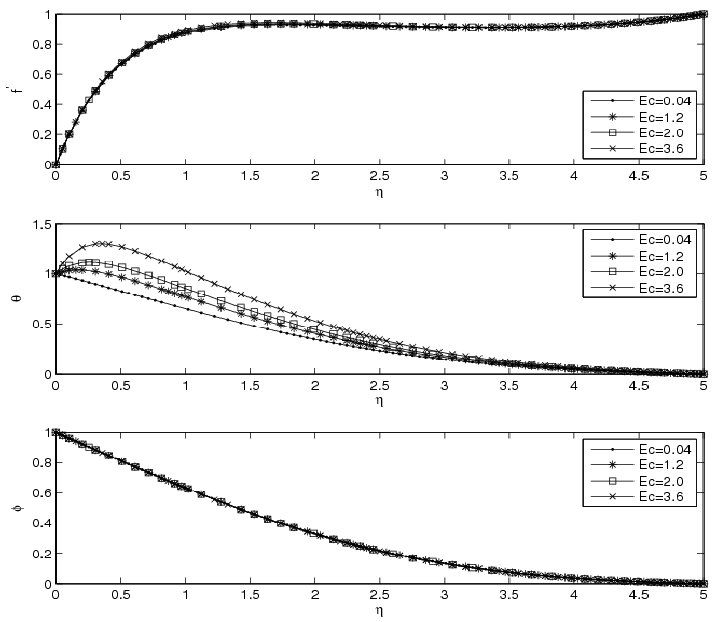
![]()
![]()
Gr = 3.2; Gc = 3.5; M = 0.5; = 4; Pr =0.71; N =0.04; Sc=0.6; = 0.1
Figure 2
IJSER © 2012
International Journal of Scientific & Engineering Research, Volume 3, Issue 6, June-2012 6
ISSN 2229-5518
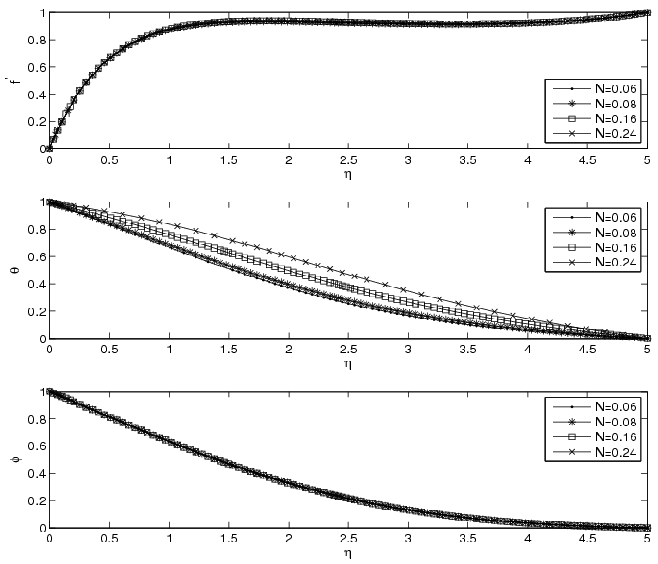
![]()
![]()
Gr = 3.2; Gc = 3.5; M = 0.5; = 4; Pr =0.71; Ec =0.02; Sc=0.6; = 0.
Figure 3
IJSER © 2012
International Journal of Scientific & Engineering Research, Volume 3, Issue 6, June-2012 7
ISSN 2229-5518
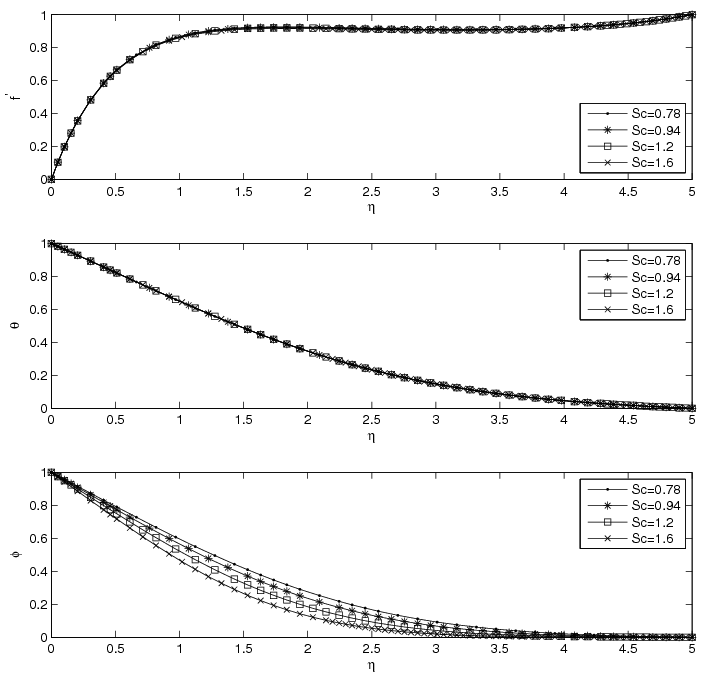
![]()
![]()
Gr = 3.2; Gc = 3.5; M = 0.5; = 4; Pr =0.71; Ec =0.02; N = 0.04; = 0.1
Figure 4
IJSER © 2012
Internatio nal Jo urnal of Scientif ic & Engineering Resea rch, Volume 3, Issue 6, June-2012 8
ISSN 2229-5518

- Gr=1 .5
Gr=3
8 Gr=7
* Gr=1 0
0 0.5 1 1.5 2 2.5 3 3.5 4 4.5 5
f[

1
CI>
Gr=1 .5
Gr=3
8 Gr=7
* Gr=1 0
![]()
0.5 1 1.5 2 2.5
ll
3 3.5 4 4.5 5
![]()
Gr=1 .5
Gr=3
Gr=7
.g..
0.6 Gr=1 0
0.4![]()

0.2
![]()
0
0 3.5 4 4.5 5
Figure 5
Gc = 3.5; M = 0.5; o = 4; Pr =0.71; Ec =0.02; N = 0.04; Sc=0.6; oJ = 0.1
IJSER lb)2012
htt p://www .'lser. ora
International Journal of Scientific & Engineering Research, Volume 3, Issue 6, June-2012 9
ISSN 2229-5518
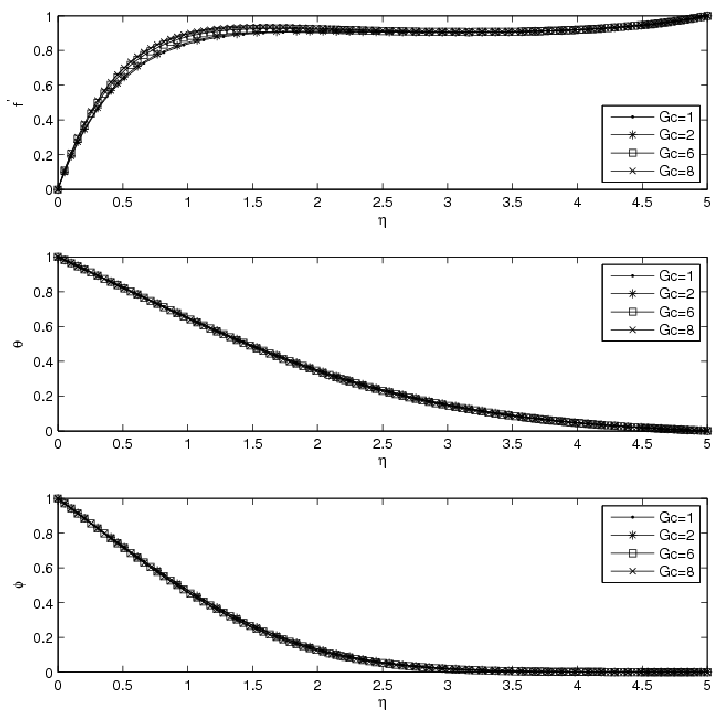
![]()
![]()
Gr = 3.2; M = 0.5; = 4; Pr =0.71; Ec =0.02; N = 0.04; Sc=1.6; = 0.1
Figure 6
IJSER © 2012
International Journal of Scientific & Engineering Research, Volume 3, Issue 6, June-2012 10
ISSN 2229-5518
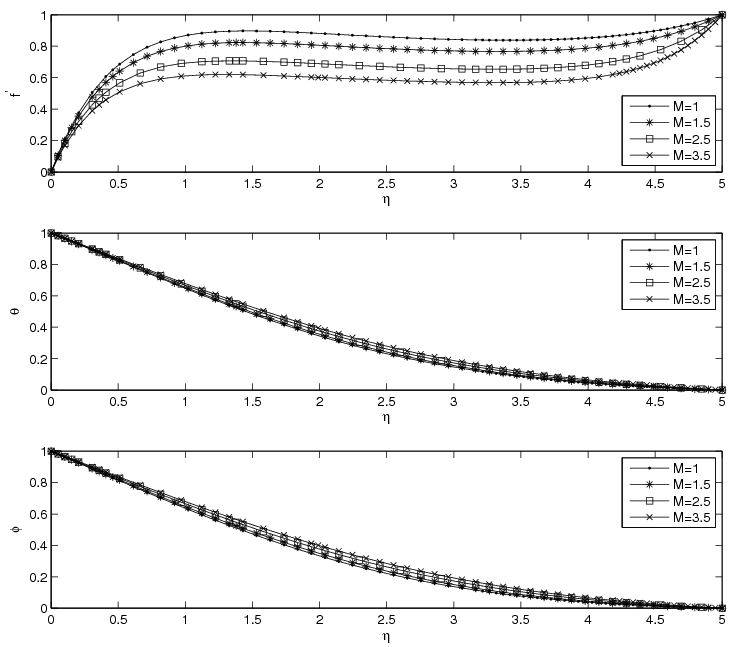
![]()
![]()
Gr = 3.0; Gc = 3.5; = 4; Pr =0.71; Ec =0.02; N = 0.04; Sc=0.6; = 0.1
Figure 7
IJSER © 2012
International Journal of Scientific & Engineering Research, Volume 3, Issue 6, June-2012 11
ISSN 2229-5518
References
1. E.M.Sparrow, R.Eichhorn and J.L.Grigg, “Combined forced
and free convection in a boundary layer”, Physics of Fluids
2,319-320, 1959.
2. E.M.Sparrow and R.B.Husar, “Longitudinal vortices in natu-
ral convection flow on inclined plates”, J. Fluid. Mech., 37,
251-255, 1969.
3. B.Gebhart, “Heat Transfer, 2nd Ed. McGraw-Hill”, New York,
1971.
4. P.Cheng, “Combined free and forced convection flow about
inclined surfaces in porous media”, Int. J. Heat Mass Transfer
20, 807-814, 1977.
5. B.Gebhart, L.Pera, “The nature of vertical natural convection flows resulting from the combined buoyancy effects of thermal and mass diffusion”, Int. J. Heat and Mass Tran., 14,
2025-2050, 1971.
6. P.Ganesan, G.Palani, “Finite difference analysis of unsteady natural convection MHD flow past an inclined plate with variable surface heat and mass flux”, Int. J. Heat Mass Trans- fer, 47, 4449-4457, 2004.
7. E.M.A. Elbashbeshy, M.F.Dimian, “Effects of radiation on
the flow and heat transfer over a wedge with variable viscos-
ity”, Appl. Math. Comput., 132, 445-454,2002.
8. R. Kandasami, K.Periasami and K. K. S. Prabhu, “Effects of chemical reaction ,heat and mass transfer along a wedge with heat source and concentration in the presence of suc- tion or injection”, Int. J. heat and mass transfer, 48, 1388- 1396,
2005.
9. R. Kandasami, I.Hashim, Muhaimin and Ruhaila, “Effects of
variable viscosity, heat and mass transfer on nonlinear
mixed convection flow over a porous wedge with heat radia- tion in the presence of homogeneous chemical reaction”, ARPN J. Engg. Applied Sci., 2, 44-53, 2007
10. M.A.Mansour, N.F.El-Anssary and A.M.Aly, “Chemical reaction and magnetohydrodynamic effects on free convec- tion flow past an inclined surface in a porous medium”, 13,
87-96, 2010.
11. I.A.Badruddin, Z.A.Zainal, Zahid A. Khan, Z.Mallick, “Ef- fects of viscous dissipation and radiation on natural convec- tion in a porous medium embedded within vertical annu- lus”, Int. J. Thermal Sci., 46, 221-227, 2007.
12. Dulal Pal and S.Chatterjee, “Heat and mass transfer in MHD
non-Darcian flow of a micropolar fluid over a stretching sheet embedded in a porous media with non –uniform heat source and thermal radiation”, Communications in Nonlinear Science and Numerical Simulation, 15, 1843-1857, 2010.
13. M.S.Abel,E.Sanjayanand and M.M.Nandeppanavar, “Viscoe-
lastic MHD flow and heat transfer over a stretching sheet with viscous and ohmic dissipations”, Communications in Nonlinear Science and Numerical Simulation, 13, 1808-1821,
2008.
14. D.A.Nield, “Modelling fluid flow in saturated po rous media and at interfaces”, Transport phenomena in porous media II (Edited), Pergamon, 2002
15. Amgad Salama, “On the Brinkman equation and the concept
of viscous dissipation in porous media”, Special Topics & Re- views in Porous Media, 2, 83-89, 2011.
16. H. Schlichting, “Boundary layer theory”, New York, McGraw- hill, 1955.
17. Nield and Bejan, “Convection in porous media”, Adrian, 3rd
edition, 2006.
IJSER © 2012